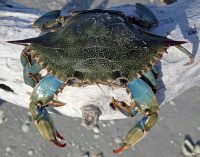The scientific name of the Blue crab (callinectes sapidus) is a mix of Greek and Latin words. Literally, the word callinectes means “beautiful swimmer” while sapidus means “savory”. It belongs to the family of swimming crabs: Portunidae.
Unlike other crabs from this family, blue crabs do not have internal spine inside the middle part of their claws. The abdomen (called apron) of male crabs are shaped like a “T”. The male and female crabs have different colored claws (chelipeds) and the shapes of their abdomen are also changed. Unlike males, the abdomen of a female crab is broad and rounded. Likewise, the tips of the claws in male crabs are red-colored while the rest of the claw is blue. In female crabs, the tips are purple while remaining part is orange. Blue crab has four frontal teeth and its carapace is brown-colored.
The width of its carapace is 23 centimeters and it weighs up to 2 pounds.
On average, it has a lifespan of 1 to 3 years.
It reaches maturity at 1 to 1.5 years of  age. A female crab mates for only once in its life and mating occurs in the warmest months of summer.
age. A female crab mates for only once in its life and mating occurs in the warmest months of summer.
In one brood, a female blue crab spawns about 2 million eggs. The eggs of these crabs are hatched in high saline coastal waters.
Blue crabs are distributed across the western coasts of the Atlantic Ocean. They are present all the way from Cape Cod to Argentina as well as the shores of the Gulf of Mexico.
Blue crab is an omnivorous animal that likes to feed on small plants and fish, as well as mussels, ringed worms, marine mollusks and snails. It also prefers to scavenge carrion from the ocean floor.
There are several natural predators of blue crabs. Some of the fishes that eat these crabs are Atlantic striped bass, croakers, Norfolk spot, trout and eels. Apart from these, sharks, rays and humans also pose danger to their survival.
They are also vulnerable to numerous diseases, bacteria and viruses.
Other Names: Atlantic Blue crab, Chesapeake Blue crab





